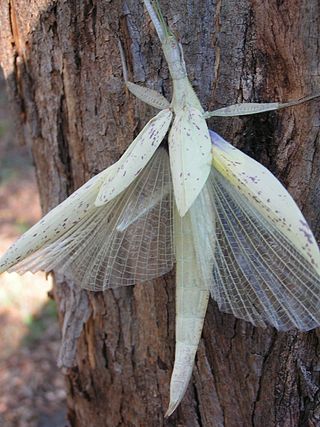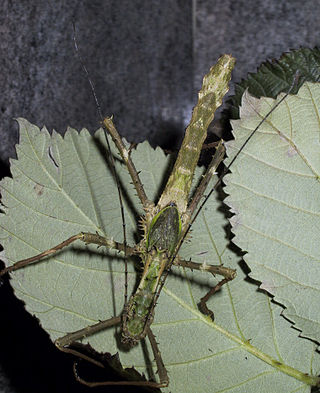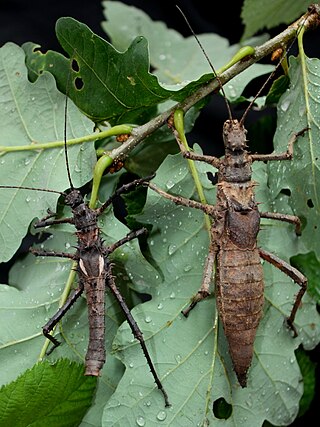
The Phasmatodea are an order of insects whose members are variously known as stick insects, stick-bugs, walkingsticks, stick animals, or bug sticks. They are also occasionally referred to as Devil's darning needles, although this name is shared by both dragonflies and crane flies. They can be generally referred to as phasmatodeans, phasmids, or ghost insects, with phasmids in the family Phylliidae called leaf insects, leaf-bugs, walking leaves, or bug leaves. The group's name is derived from the Ancient Greek φάσμα phasma, meaning an apparition or phantom, referring to their resemblance to vegetation while in fact being animals. Their natural camouflage makes them difficult for predators to detect; still, many species have one of several secondary lines of defense in the form of startle displays, spines or toxic secretions. Stick insects from the genera Phryganistria, Ctenomorpha, and Phobaeticus include the world's longest insects.

Dryocampa rubicunda, the rosy maple moth, is a small North American moth in the family Saturniidae, also known as the great silk moths. It was first described by Johan Christian Fabricius in 1793. The species is known for its wooly body and pink and yellow coloration, which varies from cream or white to bright pink or yellow. Males have bushier antennae than females, which allow them to sense female pheromones for mating.

Extatosoma tiaratum, commonly known as the spiny leaf insect, the giant prickly stick insect, Macleay's spectre, or the Australian walking stick, is a large species of Australian stick insect. The species has the Phasmid Study Group number PSG9.

Heteropteryx is a monotypic genus of stick insects containing Heteropteryx dilatata as the only described species. and gives its name to the family of the Heteropterygidae. Their only species may be known as jungle nymph, Malaysian stick insect, Malaysian wood nymph, Malayan jungle nymph, or Malayan wood nymph and because of their size it is commonly kept in zoological institutions and private terrariums of insect lovers. It originates from the Malay Archipelago and is nocturnal.

Acrophylla titan, the titan stick insect, is the second-longest stick insect found in Australia. First described by William Sharp Macleay in 1826, it was considered to be the longest stick insect in the world until the discovery of Ctenomorpha gargantua.

Tropidoderus childrenii, the Children's stick insect, was first described in 1833 by Gray.

Eurycnema goliath, commonly known as the goliath stick insect, or the regal stick insect, is a large species of stick insect in the family Phasmatidae, endemic to Australia and considered one of the largest species of stick insects in the country. The species has the Phasmid Study Group number PSG14.

Diapheromera covilleae, the creosote bush walkingstick, is a species of stick insect in the family Diapheromeridae. They are about 5 to 10 centimetres long depending on the sex, with large tarsal hooks at the end of each leg for superior grip to branches or other objects. They have small eyes and horn-like spines on the head and anus. Since they do not have wings, they travel by walking along branches of trees and bushes, sometimes walking along the ground in search for the next perch or food source. Females are usually 3 to 4 centimetres longer than males and have a larger body. Females are also grey in color while males are more brown.

Pulchriphyllium bioculatum, Seychelles leaf insect, Javanese leaf insect, or Gray's leaf insect, is a leaf insect of the family Phylliidae native to tropical Asia as well as Madagascar, Mauritius and the Seychelles. It was first described by George Robert Gray in 1832 and was the first phasmid he discovered. Leaf insects have extremely flattened, irregularly shaped bodies, wings, and legs. They are usually about 5–10 cm long. They are called leaf insects because their large, leathery forewings have veins that look similar to the veins on the particular type of leaves they inhabit. Its scientific name bioculatum means "two-eyed" and refers to the two dots located on the abdomen just in this species.

Eurycantha calcarata is a species of phasmid endemic to Australasia.

Psyttala horrida is an insect in the assassin bug genus Psyttala. It is commonly called the horrid king assassin bug or giant spiny assassin bug, and the scientific name is commonly misspelled as Psytalla.

The Heteropterygidae is a family of stick insects belonging to the suborder Euphasmatodea. Species can be found in Australasia, East and Southeast Asia. More than 130 valid species have been described.

Achrioptera manga is a species of phasmid or stick insect of the genus Achrioptera, found in Madagascar and the Comoros Archipelago. Stick insects usually blend into their background, but the male A. manga is blue, standing out against the surrounding foliage. It is one of the largest insects, able to reach lengths of 24 centimetres (9.4 in).

Orestes dittmari is a species of stick insects in the subfamily Dataminae.

Orestes bachmaensis is a Phasmatodea species native to central Vietnam.

Haaniella erringtoniae is a stick insect species. It is a typical representative of the subfamily Heteropteryginae. The occasionally used common name Errington's Haaniella refers to the species name.

Haaniella dehaanii is a stick insect species. It is a typical representative of the subfamily Heteropteryginae. The occasionally used common name De Haan's haaniella refers to the species name.

Haaniella scabra is a species of stick insect native to Borneo and a typical representative of the subfamily Heteropteryginae. The occasionally used common name Small Haaniella refers to the size of this.

Haaniella gintingi is a stick insect species from Sumatra. It is a typical representative of the subfamily Heteropteryginae. The occasionally used common name Ginting’s Haaniella refers to the species name.

Haaniella grayii is a stick insect species native to Borneo. It is a typical representative of the subfamily Heteropteryginae and the largest species of the genus Haaniella. The occasionally used common name Gray's Haaniella refers to the species name.




















